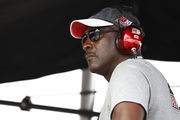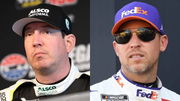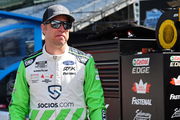
via Imago
Syndication: Daytona Beach News-Journal Ryan Preece flips multiple times during the running of the Coke Zero Sugar 400 at Daytona International Speedway, Saturday, Aug. 26, 2023. , EDITORIAL USE ONLY PUBLICATIONxINxGERxSUIxAUTxONLY Copyright: xNigelxCook/News-Journalx 21286668 Image Credits: Imago

via Imago
Syndication: Daytona Beach News-Journal Ryan Preece flips multiple times during the running of the Coke Zero Sugar 400 at Daytona International Speedway, Saturday, Aug. 26, 2023. , EDITORIAL USE ONLY PUBLICATIONxINxGERxSUIxAUTxONLY Copyright: xNigelxCook/News-Journalx 21286668 Image Credits: Imago
Daytona International Speedway is once again under the microscope as major safety revamps are being discussed. At the heart of the conversation lies the historic bus stop backstretch, which has undergone significant changes. The removal of grass from the backstretch has sparked debate, raising questions about safety, aesthetics, and the future of racing at Daytona.
The Le Mans Chicane was once a high-risk overtaking zone, where drivers skillfully navigated the grass and curbing. However, the 2023 August race raised questions on the safety of the track when Ryan Preece had a horrific crash. After getting airborne because of a crash, the driver flipped violently ten times across the grass. This forced NASCAR officials to make drastic safety changes.
ADVERTISEMENT
Article continues below this ad
The problem: Safety changes stir controversy
Amid the ongoing Rolex 24, NASCAR President Frank Kelleher triggered a new debate by saying that they are looking to make several changes to the track. While these changes aim to prioritize driver safety, they’ve triggered a mix of support and criticism from fans and drivers alike.
Officials replaced the grass around the chicane with pavement to reduce the risk of crashes like Ryan Preece’s. In January 2024, they paved just one part of the backstretch. However, before the 2025 season, they completely paved the backstretch. Despite these measures, the changes have drawn mixed reactions. Drivers testing during the Roar Before the Rolex 24 noticed the new asphalt created a stark contrast. This made the chicane harder to navigate.
However, NASCAR president Frank Kelleher defended the decision. “In the overarching spirit of everything that races at Daytona, from stock cars to sports cars, we had to make changes in the back in the name of keeping our athletes safe,” he told NBC Sports.
Daytona President Frank Kelleher says the track is working toward an aesthetic fix for the backstretch at Daytona but they “take their time” with it
— BrakeHard (@BrakeHardBlog) January 25, 2025
Meanwhile, without the familiar reference points provided by the grass, many felt the section resembled a parking lot rather than a world-class racetrack. Many fans and drivers have also raised concerns about the loss of aesthetic charm. Watching dirt fly as cars brushed the grass was a signature moment at Daytona.
What’s your perspective on:
Has Daytona lost its iconic charm with the removal of grass, or is safety the real winner?
Have an interesting take?
Kelleher addressed this issue as well, admitting that the track doesn’t look good. “Watching the cars go through the chicane at the Roar, aesthetically, it didn’t look like Daytona. We will look at the area and from an aesthetic standpoint, if we have time and money on our side, we could look at what other racetracks have done to make it not look like a parking lot,” Kelleher said.
It’s worth noting that many fans and drivers had demanded NASCAR use artificial grass on the backstretch to keep both safety and aesthetics in mind. The proposed revamp of Daytona’s Le Mans Chicane could take inspiration from other speedways that have tackled similar challenges.
Charlotte Motor Speedway, for instance, replaced grass with synthetic turf on its front stretch in 2018, improving safety while maintaining visual appeal. Yet, questions remain about the practicality of turf at Daytona. While it may enhance aesthetics, turf has its risks. In 2022 Chris Buescher had a similar flip at the Charlotte. Although it was not as horrific as the Preece, one Astroturf possesses its challenges.
ADVERTISEMENT
Article continues below this ad
Trending
What’s next for Daytona International Speedway?
As Daytona International Speedway faces mounting pressure to balance safety with tradition, the stakes couldn’t be higher. The loss of grass has changed the track’s iconic look. Daytona officials are exploring options to strike the right balance. They may add green paint to the asphalt or install tire barriers and curbs. These changes could restore some of the chicane’s character without compromising safety.
Kelleher emphasized that the track has time to refine its approach. He said, “I’m confident that we will come up with something that is representative of the World Center of Racing.” Another idea gaining traction is enforcing stricter penalties for overshooting the chicane, similar to measures in place at the Charlotte Roval. By combining these strategies, Daytona could address safety concerns while preserving the chicane’s iconic status.
ADVERTISEMENT
Article continues below this ad
Ultimately, Daytona’s efforts to revamp the chicane signal a new era for one of motorsport’s most iconic venues. It will be hard to satisfy both safety advocates and traditionalists. One thing is certain: NASCAR is determined to keep the “World Center of Racing” without compromising its legacy or the safety of its athletes.
Have something to say?
Let the world know your perspective.
ADVERTISEMENT
ADVERTISEMENT
ADVERTISEMENT
ADVERTISEMENT







Has Daytona lost its iconic charm with the removal of grass, or is safety the real winner?